14. Writing Essays¶
Some courses include assignments that require written responses to questions that might not have simple or definitive answers. To score one of these essay style assignments, you might be asked to do one or more of the following.
- Assess your own work.
- Assess the essays written by other learners.
To receive your score for an essay style assignment, you might receive one or more of the following.
- Assessments from other learners in the course.
- An assessment from a member of the course team.
Because these essay assignments have a flexible design and can include different assessment options, they are called open response assessments.
This topic describes how to work with open response assessments in your edX course.
14.1. Overview of Open Response Assessments¶
In an open response assessment, you provide written responses to questions that might not have simple or definitive answers. For some open response assessments, you can submit an image or other file to accompany a written response.
14.1.1. The Steps in an Open Response Assessment¶
In addition to your own responses to the questions in the assignment, open response assessments have several steps that can include assessment training steps, peer assessments, self assessment, and staff assessments.
In training steps, you perform assessments of sample responses that the course team provides. The goal is to give the sample response the same grade that a member of the course team would have given. For more information, see Learn to Assess Responses.
In peer assessments, you perform assessments of responses that other learners in the course have submitted, and other learners in the course also assess your responses. For each assignment, your course team decides the number of peer assessments that you have to perform. For more information, see Assess Peer Responses.
In self assessments, you assess your own response. For more information, see Assess Your Response.
In staff assessments, members of the course team assess your response. For more information, see Staff Grade.
Note
Course staff can grade your open response assignment even if a staff assessment step is not included in the assignment. This might happen if, for example, you receive peer assessments of your response that are inappropriate. In such cases, course staff can perform an assessment of your response that overrides any peer assessment grades.
14.1.2. The Rubric, Criteria, and Options¶
Every open response assessment has a rubric that the course team provides, to be used as guidance for grading. The rubric is a list of expectations that the response should meet. Grading for all the types of assessments in an open response assessment is done by comparing each response against the same rubric.
Rubrics consist of criteria and options.
- Criteria describe characteristics that each response should have, such as concepts that a response should cover, or the amount of supporting information that a response must include.
- Each criterion has options, which describe how well each response satisfies the criterion. These are usually a range of ratings, for example “Fair”, “Good”, or “Excellent”.
The following image shows a rubric with two criteria. Each of the criteria has several options.
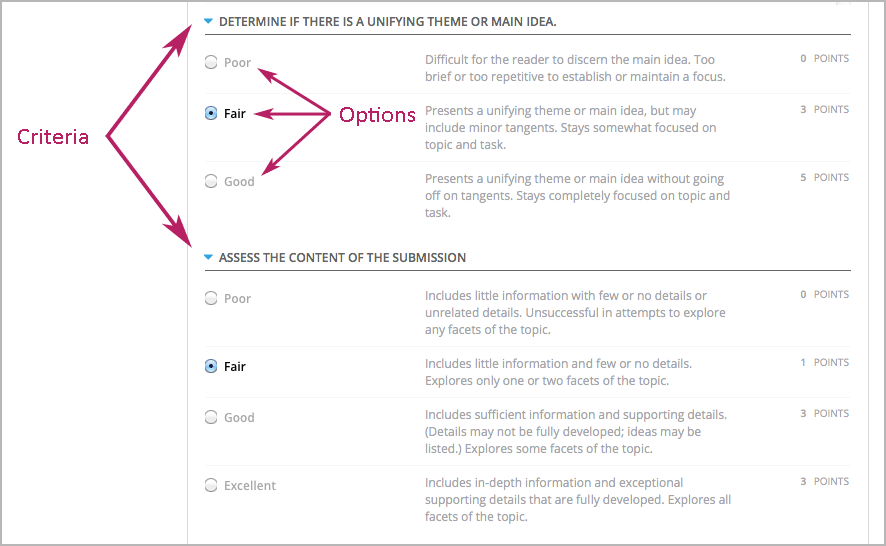
When you assess a response, you select the option that best describes how well the response met each of the criteria.
Some open response assessments provide a Top Responses section that shows the top scoring responses for the assignment and the scores that these responses received. If it is provided, this section appears below your score after you complete each step of the assignment.
14.2. Completing an Open Response Assessment¶
When you come to an open response assessment in the course, you see the questions you must answer, with a response field for each question in the assignment. After you enter and submit your response, you assess some of your peers’ responses, your own response, or both, depending on the assignment. Below the final response field in the Your Response step, you can see the steps that your assignment includes.

The following topics describe how you complete an open response assessment that includes a learner training step, a peer assessment step, a self assessment step, and a staff grade step.
At any time during an assessment, you can see your progress at the bottom of the page under Your Grade. A message indicates the steps that must still be completed before you can receive your final grade for the assignment. For example, you might see the following message.
Not Completed
You have not completed the peer assessment step and self assessment step of
this problem.
14.2.1. Submit Your Response¶
To submit your response, follow these steps.
Read each question carefully. Some course teams include important information in the question, such as how long a response must be, or specific topics that your response must cover.
Note
The total word count for the assessment cannot be more than 10,000 words (approximately the equivalent of 20 pages of 8.5x11 inch paper, with text single-spaced).
For each question, enter your response into the field under Your Response.
When you have completed all of the questions, select Submit your response and move to the next step.
If you need more time, you can select Save Your Progress to save a draft of your responses, and then come back and submit them later.
After you submit your responses, the next step, which is usually either assessment training or peer assessment, starts immediately. However, you do not have to start the next step right away. If you want to stop working and come back later, just refresh or reopen your browser when you come back.
Note
You can view your own responses at any time after you submit them. To do this, for the response you want to view, select the Your Response heading to expand the response field. Your response appears, along with the status of your response, and information about additional steps you have to complete before you receive your grade.

14.2.1.1. Submit a File with Your Response¶
For some assignments, you might be asked to submit a file along with your text response. Those assignments include Choose File and Upload your file options below the response field. Note the following requirements.
- A text response is always required. If you upload a file in your response, also include a text response that describes the file you have uploaded in such a way that a reviewer who cannot access the uploaded file can still assess the text content of your response using a screen reader or other text parsing tool.
- You can upload only one file to submit with your response.
- The file that you upload must be smaller than 5 MB in size.
- Image files can be in .jpg, .gif, or .png format.
To upload your file, follow these steps.
- Below the response field, select Choose File.
- Select the file that you want to upload, and then select Open.
- Select Upload your file.
The name of the file that you selected and uploaded appears below the response field.
You can replace the file that you uploaded with a different one until you submit your response. To do so, follow steps 1-3 again.

14.2.2. Learn to Assess Responses¶
As part of an open response assessment, you learn how to assess responses effectively by reviewing and assessing sample responses provided by the course team. You then try to give the sample responses the same scores that the course team selected.
Note
Not all course teams provide sample responses for training. If the course team did not provide sample responses, this step is not included in the assignment.
After you submit your own response, a sample response appears along with the rubric for the assignment. Read the sample response and the rubric carefully, select the options that you think best reflect the response, and then select Compare your selections with the instructor’s selections.
- If all of your selections are the same as the defined selections, the next sample response opens automatically.
- If any option that you select is not the same as the defined selection, you see the response again, and the following message appears above the response.
Learning to Assess Responses
Your assessment differs from the instructor's
assessment of this response. Review the response and consider why the
instructor may have assessed it differently. Then, try the assessment again.
For each of the criteria, you see one of the following two messages, depending on whether your selections matched those defined by the course team.
Selected Options Agree
The option you selected is the option that the instructor selected.
Selected Options Differ
The option you selected is not the option that the instructor selected.
In the following example, the learner chose one correct option and one incorrect option.
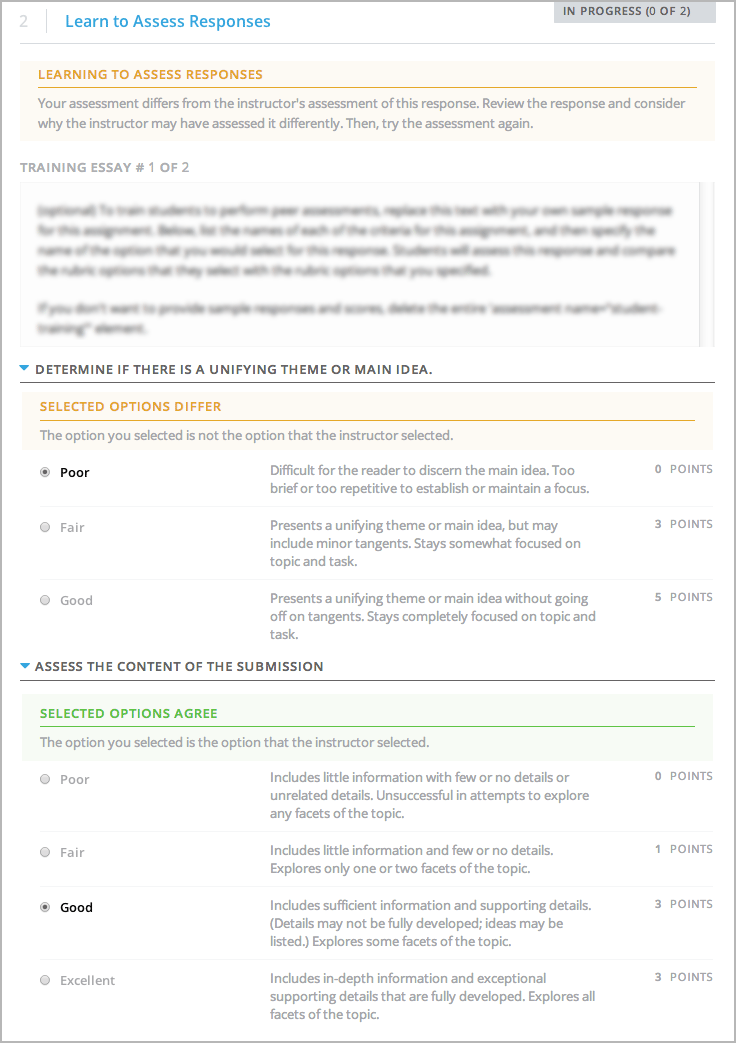
You continue to assess the sample response until the options you select for all criteria match the options defined by the course team.
When you have successfully assessed all of the sample responses, you move to the next step in the assignment.
14.2.3. Assess Peer Responses¶
When the peer assessment step starts, you can see counts of how many responses you are expected to assess and how many you have already assessed at the top of the page. Then you see each original question, another learner’s response, and the rubric for the assignment.

You assess other learners’ responses by selecting options in the rubric. This process will be familiar to you if your assignment included the learn to assess responses step. Additionally, this step has a field below the rubric where you can provide comments about the learner’s response.
Note
Some assessments might have a Comments field for one or more of the assessment’s individual criteria. You can enter up to 300 characters in these fields. In the following image, both criteria have a Comments field. There is also a field for overall comments on the response.
After you have selected options in the rubric and provided additional comments about the response, select Submit your assessment and move to response #{number}.
When you submit your assessment of the first learner’s response, a response from another learner opens for you. Assess each response in the same way that you assessed the first learner’s responses, and submit each assessment. You repeat these steps until you have assessed the required number of responses. The count of how many responses you have assessed updates after you assess each response.
If there are no new submitted responses available for grading, a status message indicates that no peer responses are currently available for you to assess, and that you should check back later.
14.2.4. Assess Additional Peer Responses (optional)¶
If you have assessed the required number of peer responses, the peer assessment step “collapses” so that only the Assess Peers heading is visible.
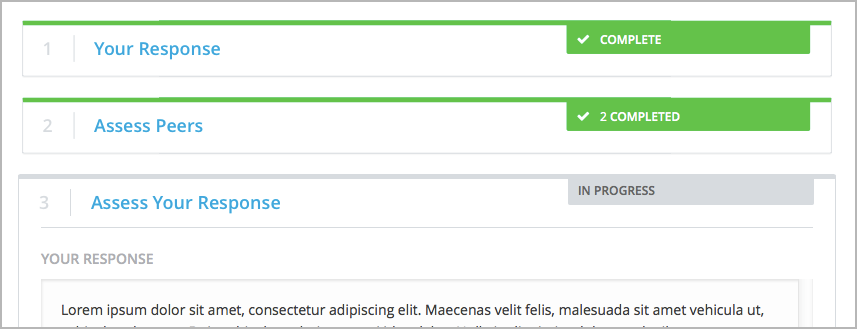
If you want to, you can assess more peer responses than the assignment requires. To assess more responses, select the Assess Peers heading to expand the step, and then select Continue Assessing Peers.
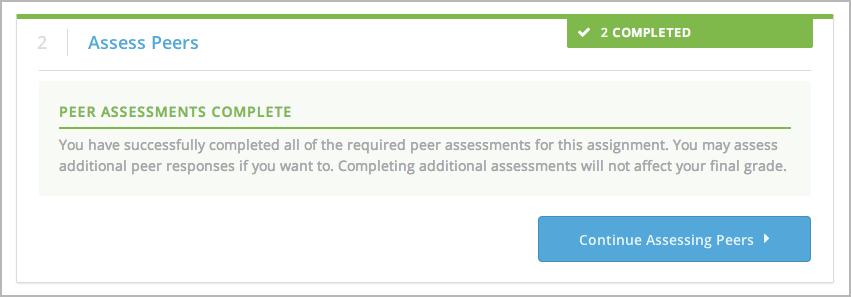
14.2.5. Assess Your Response¶
When you have completed the required number of peer assessments, your self assessment opens. You see your response along with the same rubric that you used in the peer assessment step. Assess your response, and then select Submit Your Assessment.
14.2.6. Staff Grade¶
In some assignments, a staff assessment step is included for a member of the course team to grade your responses. You do not need to take any action for this step. The status of the Staff Grade step changes to Complete when a member of the course team has completed grading your response.
If a Staff Grade step exists in your assignment, you receive your final assignment grade when staff grading is complete, even if your response has not been assessed by the required number of peer reviewers.
Note
Course staff can grade your open response assignment even if a staff assessment step is not included in the assignment. This might happen if for example you receive peer assessments of your response that are inappropriate. In such cases, course staff can perform an assessment of your response that overrides any peer assessment grades. If a member of the course staff has graded your response, a Staff Grade section appears in the grading details for your assignment.
14.2.7. Receive Your Score and Provide Feedback¶
After you submit your self assessment, if other learners are still assessing your response, you see this message under the Assess Your Response step.
Your Grade: Waiting for Peer Assessment
Your response is still undergoing peer assessment. After your peers have
assessed your response, you will see their feedback and receive your final
grade.
If you see this message, keep checking back periodically until the peer assessments of your work are complete.
When peer assessment is complete, and if the assignment does not include a staff assessment step, you can see the scores you received from all of the peers who scored your work, as well as your self assessment. You can also see any additional comments that your peers have provided.
If you want to, you can provide feedback on the peer scores that you received, under Provide Feedback on Peer Assessments.

If the assignment included a staff assessment step, you receive your final grade when a member of the course team has graded your response. If a staff assessment step is included in the assignment, peer assessment grades and comments are included in the assignment grade details, but the staff grade becomes the final grade.
14.3. Peer Assessment Scoring¶
Note
If a staff grade is provided in the assignment, either because a staff assessment step was included or because a member of the course team graded your response to override inappropriate peer assessments, peer assessments are not taken into account in the grading. If a staff grade exists, it is always your final grade.
Peer assessments are scored by criteria. An individual criterion’s score is the median, not the average, of the scores that each peer assessor gave that criterion. For example, if the Ideas criterion in a peer assessment receives 10 from one learner, 9 from a second learner, and 5 from a third learner, the score for that criterion is 9 (the median), not 8 (the average).
Your final score for a peer assessment is the sum of the median scores for each individual criterion.
For example, a response might receive the following scores from peer assessors.
| Criterion Name | Peer 1 | Peer 2 | Peer 3 | Median |
|---|---|---|---|---|
| Ideas (out of 10) | 10 | 7 | 8 | 8 |
| Content (out of 10) | 7 | 9 | 8 | 8 |
| Grammar (out of 5) | 4 | 4 | 5 | 4 |
To calculate the final score, the system adds the median score for each criterion.
Ideas median (8 out of 10) + Content median (8 out of 10) + Grammar median (4 out of 5) = final score (20 out of 25)
Note, again, that your final score is not the median of the scores that each individual peer assessor gave the response.
14.3.1. View Top Responses (optional)¶
If the course team included a Top Responses section, you can review the highest-scoring responses submitted for each question. This section appears only after you have completed all the steps of the assignment.
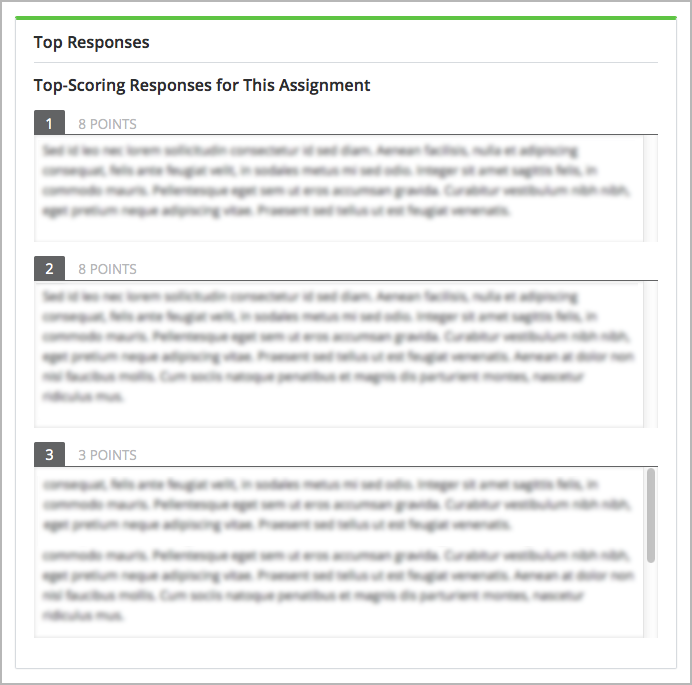
14.4. Canceled Responses¶
If the course team deems a response that you have submitted to be inappropriate, they can cancel that response and remove it from peer grading. In the open response assessment you see an indicator that your submission was canceled, with the date and time of the cancellation, and a comment by the course team member about the reason.
The course team might allow you to submit a replacement response for the canceled one, or they might not. If they do not allow you to submit a replacement response, your grade is zero for the assignment.
14.5. Try an Example Open Response Assessment Problem¶
If you want to try an example open response assessment problem, check out the edX demonstration course, edX Demo course. In addition to giving you a tour of a typical edX course, the edX Demo course contains information about open response assessments and an example peer assessment.
